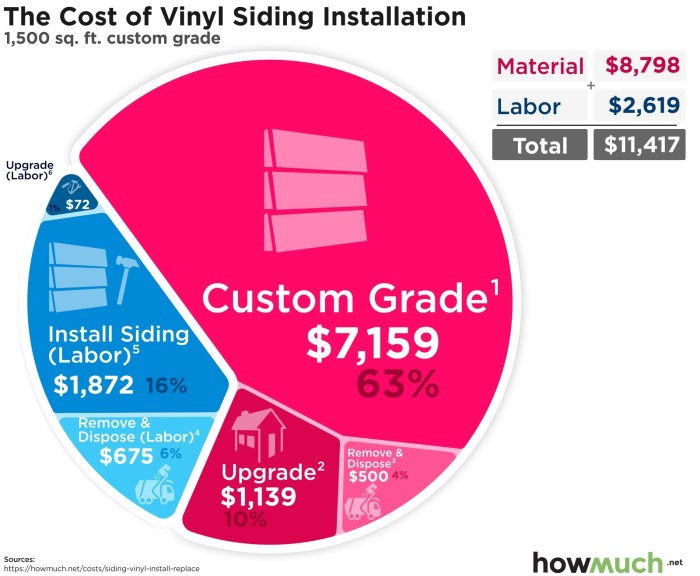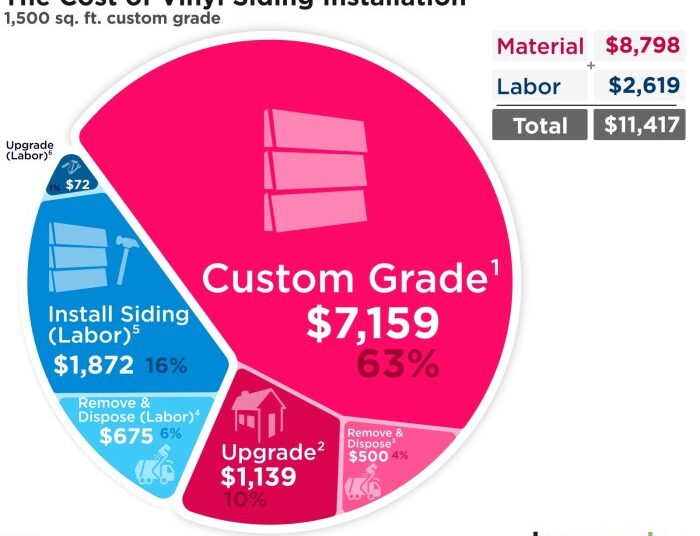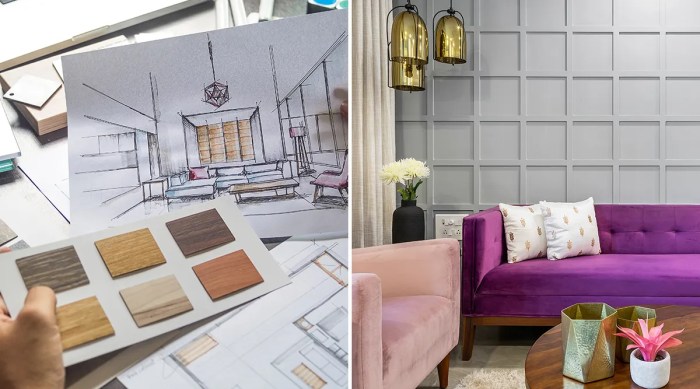Exploring the cost to install new vinyl siding opens up a world of considerations. From the factors influencing costs to the breakdown of expenses, DIY versus professional installation, and regional variations, this topic delves into the intricacies of vinyl siding installation costs.
Get ready to uncover the essential details behind the price tag of revamping your home's exterior with vinyl siding.
Factors Affecting Cost

When it comes to the cost of installing new vinyl siding, several factors can influence the overall price. Understanding these factors can help homeowners make informed decisions and budget accordingly.
Size of the House
The size of the house is a significant factor in determining the cost of installing vinyl siding. Larger homes require more materials and labor, which can increase the overall cost of the project. Additionally, more extensive homes may have complex architectural features that can affect the installation process and, consequently, the price.
Quality and Type of Vinyl Siding
The quality and type of vinyl siding chosen for the installation can also impact the cost. Higher-quality materials typically come with a higher price tag but may offer better durability and appearance. Additionally, certain types of vinyl siding, such as insulated siding or specialty finishes, may cost more than standard options.
Complexity of the Installation Job
The complexity of the installation job plays a crucial role in determining the pricing. Factors such as the presence of obstacles, intricate design elements, or the need for additional preparation work can all contribute to a more labor-intensive and time-consuming installation process.
As a result, the cost of the project may increase to account for these additional complexities.
Cost Breakdown
When it comes to installing new vinyl siding, it's important for homeowners to understand the breakdown of costs involved. This includes labor, materials, and any additional expenses that may arise throughout the process.
Labor Costs
Labor costs typically make up a significant portion of the total expenses for installing new vinyl siding. The cost of labor is usually calculated based on the size of the project, complexity of the installation, and the labor rates in your area.
On average, labor costs can range from $2 to $7 per square foot of siding installed.
Materials Costs
In addition to labor costs, homeowners should also consider the cost of materials required for a standard vinyl siding installation. The average cost of materials can vary depending on the quality and brand of the siding chosen, but typically range from $2 to $7 per square foot.
This cost includes the siding panels, trim pieces, nails, and other necessary materials for the installation.
Additional Costs
Aside from labor and materials, there are other expenses that homeowners should be aware of when budgeting for new vinyl siding. These additional costs may include permits, disposal of old siding, any repairs needed before installation, and potential upgrades or customizations to the siding design.
It's important to factor in these extra costs to ensure a more accurate budget for the project.
DIY vs. Professional Installation
When it comes to installing new vinyl siding, homeowners are often faced with the decision of whether to tackle the project themselves or hire professionals. Let's explore the differences in cost, potential savings, and factors to consider for both options.DIY installation can seem appealing due to the potential cost savings.
By taking on the project yourself, you can avoid labor costs associated with hiring professionals. However, it's important to consider your skill level and experience in home improvement projects. Installing vinyl siding requires precision and knowledge of proper techniques to ensure a quality outcome.
Mistakes in installation can lead to costly repairs down the line.On the other hand, hiring professionals for vinyl siding installation guarantees expertise and quality workmanship. Professionals have the necessary skills, tools, and experience to complete the job efficiently and effectively.
While this option may come at a higher cost initially, it can save you time and hassle in the long run. Additionally, professional installations often come with warranties that provide added peace of mind.
Skill Level and Experience
For homeowners with little to no experience in home improvement projects, opting for professional installation is advisable. Professionals have the expertise to handle the installation process smoothly and ensure a durable and aesthetically pleasing result. However, if you have a good understanding of carpentry and construction, and feel confident in your abilities, DIY installation may be a feasible option.
When to Hire Professionals
Consider hiring professionals if:
- You lack the necessary tools and equipment for the installation.
- You have limited time to dedicate to the project.
- You want to ensure a high-quality and long-lasting result.
- You prefer to have warranties and guarantees on the work done.
Regional Variances
When it comes to the cost of installing vinyl siding, regional variations play a significant role in determining the overall price. Factors such as location, climate, local building codes, labor costs, and market demand can all impact how much you can expect to pay for the installation.
Impact of Location and Climate
The geographical location of your property can greatly influence the cost of installing vinyl siding. Areas with higher costs of living typically have higher labor rates, which can drive up the overall cost of the project. Additionally, regions prone to extreme weather conditions may require additional preparation and materials, leading to increased expenses.
Local Building Codes and Regulations
Local building codes and regulations can also affect the cost of vinyl siding installation. Certain areas may have specific requirements for siding materials or installation methods, which could result in higher costs to meet these standards. It is essential to factor in any regulatory requirements when budgeting for the project.
Labor Costs Variation
Labor costs for vinyl siding installation can vary significantly from region to region. Areas with a high demand for skilled labor may have higher hourly rates for contractors, impacting the overall cost of the project. It is essential to research local labor rates and get multiple quotes to ensure you are getting a fair price for the work.
Market Demand and Pricing
Market demand for vinyl siding installation can also influence pricing in specific areas. Higher demand for contractors' services can lead to increased prices due to limited availability and competition among professionals. Understanding the market dynamics in your region can help you negotiate pricing and find the best deal for your vinyl siding installation project.
Final Thoughts
As we wrap up the discussion on the cost to install new vinyl siding, it becomes clear that this endeavor involves more than just monetary considerations. From understanding the complexity of installation to weighing DIY options against professional services, homeowners are equipped with the knowledge needed to make informed decisions.
So, whether you're aiming for a budget-friendly upgrade or prioritizing quality, the cost to install new vinyl siding is a key factor in transforming your home.
Commonly Asked Questions
How does the size of the house impact the overall cost?
The larger the house, the more materials and labor are typically required, leading to a higher overall cost for vinyl siding installation.
What are additional costs that homeowners should be aware of?
Additional costs may include permits, disposal of old siding, trim work, and any structural repairs needed before installation.
Is DIY vinyl siding installation cost-effective compared to hiring professionals?
While DIY can save on labor costs, mistakes can be costly. Hiring professionals ensures quality installation and may save money in the long run.
How do regional factors affect the cost of vinyl siding installation?
Regional factors such as climate, building codes, and market demand can influence material prices, labor costs, and overall installation expenses.










